|
Chorale Melodies used in Bach's Vocal Works
Hast du denn, Jesu, dein Angesicht gänzlich verborgen |
|
Melody & Text | Use of the CM by Bach | Use of the CM by other composers |
| |
|
Melody & Text: |
|
The melody of the concluding Choral is generally associated with Joachim Neander’s Thanksgiving Hymn, “Lobe den Herren, den mächtigen König der Ehren,” and was appropriated for it by him in his Glaub- und Liebesubung (Bremen, 1680). The tune originally appeared in Part II of the Stralsund Ernewertes Gesangbuch, Darinnen 408 Geistreiche Psalmen und Lieder (Stralsund, 1665), set to “Hast du denn, Jesu, dein Angesicht gäntzlich verborgen,” upon which Ahasverus Fritsch modelled his Hymn (infra). Zahn suggests a secular origin for the tune.
There is early 18th century authority for J.S. Bach’s treatment of the second part of the tune.
The melody occurs in the concluding Choral of Cantatas BWV 57, Cantata BWV 137 and in the unfinished Cantata U 3, “Herr Gott, Beherrscher aller Dinge” (BWV 120a). Organ Works, BWV 650 (“Kommst du nun, Jesu, vom Himmel herunter”). All of these works belong to his later Leipzig years. But though his form of the melody is fundamentally uniform, he treats it with a freedom which its spirited character invited. |
|
Melody: Zahn 1912a
Composer: Anon (Stralsund, 1665) |

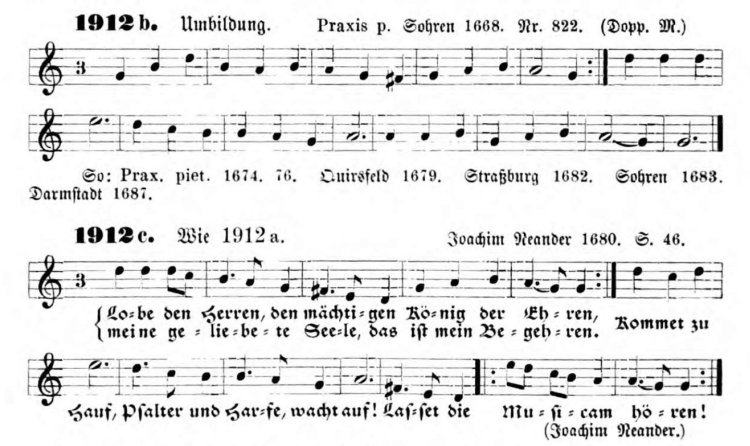 |
|
Text 1: Hast du denn, Jesu, dein Angesicht
Author: Ahasverus Fritsch (1668) |
|
Text 2: Lobe den Herren, den mächtigen König der Ehren
Author: Joachim Neander (1680) |
|
Text 3: Kommst du nun, Jesu, vom Himmel herunter auf Erden? (KGEL 172)
Author: Caspar Friedrich Nachtenhöfer (1667) |
|
Hymnal versions Bach may have known: |
| |
| |
|
Use of the Chorale Melody by Bach: |
|
Text 1: Hast du denn, Jesu, dein Angesicht |
|
Chorale Richte dich, Liebste, nach meinem Gefallen und gläube (Mvt. 8) from Cantatas BWV 57 (verse 6) |
|
The melody of the concluding Choral is generally associated with Joachim Neander’s Thanksgiving Hymn, “Lobe den Herren, den mächtigen König der Ehren,” and was appropriated for it by him in his Glaub- und Liebesubung (Bremen, 1680). The tune originally appeared in Part II of the Stralsund Ernewertes Gesangbuch, Darinnen 408 Geistreiche Psalmen und Lieder (Stralsund, 1665), set to “Hast du denn, Jesu, dein Angesicht gäntzlich verborgen,” upon which Ahasverus Fritsch modelled his Hymn (infra). Zahn suggests a secular origin for the tune.
There is early 18th century authority for J.S. Bach’s treatment of the second part of the tune.
J.S. Bach’s treatment of bars 1 and 2 after the middle double-bar is not uniform. In the two following bars (3 and 4) his melody is invariable and is found in 1708.
The words of the concluding Choral are the 6th stanza of Ahasverus Fritsch’s Hymn-dialogue between Christ and the Soul, “Hast du denn, Jesu, dein Angesicht gäntzlich verborgen.” The Hymn, based upon an earlier model (supra), was first published (without the melody) in A. Fritsch’s Zwey und Siebenzig neue Himmel-susse Jesus-Lieder (Jena, 1668).
A. Fritsch was born at Mücheln, near Merseburg, in 1629. He became Chancellor and President of the Consistory at Rudolstadt, and died there in 1701:
Form. Simple (2 Ob., Taille1, Strings, Organ, Continuo). Choralgesänge, No. 231. |
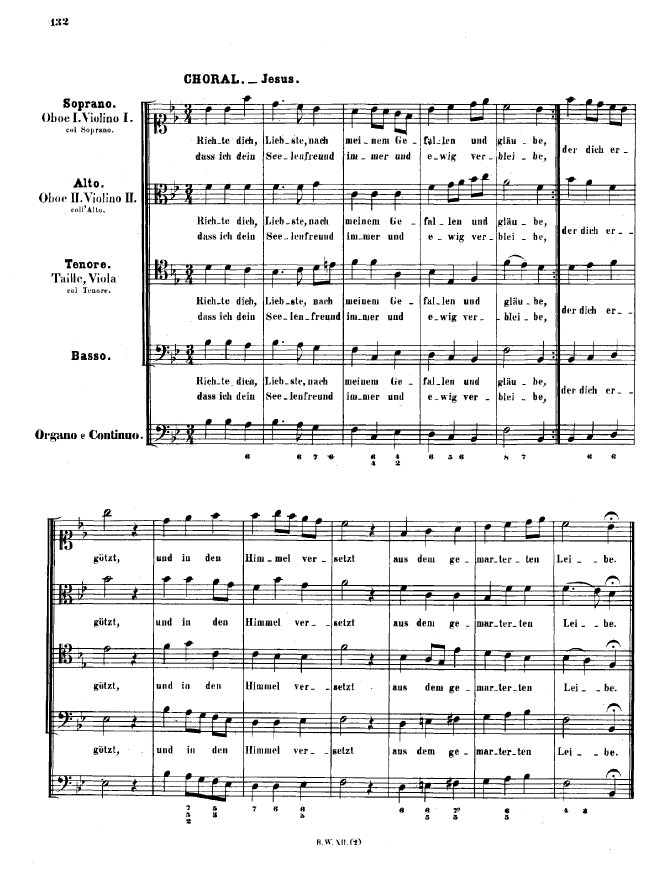 |
|
Text 2: Lobe den Herren, den mächtigen König der Ehren |
|
Chorale Lobe den Herren, der deinen Stand sichtbar gesegnet (Mvt. 8) from Cantata BWV 120a (verses 4-5) |
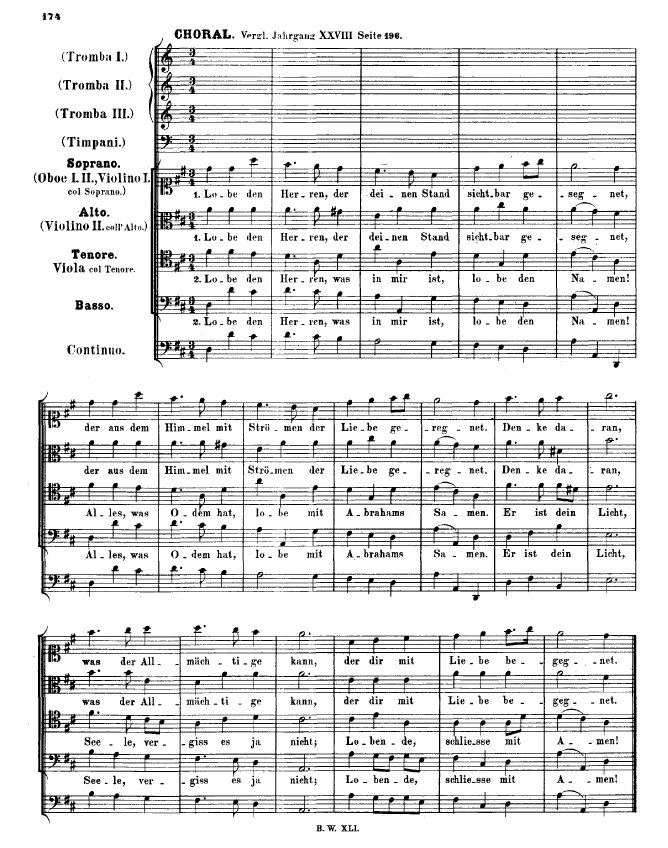 |
|
Cantata BWV 137 |
|
A Choral Cantata, on Joachim Neander’s Hymn of Thanksgiving, “Lobe den Herren, den mächtigen König der Ehren,” first published in his Glaub- und Liebesubung (Bremen, 1680).
Neander was born at Bremen in 1650. In 1674 he was appointed Rector of the Latin School at Dusseldorf, and five years later (1679) returned to Bremen as unordained assistant in the Church of St Martin. He died in 1680.
J.S. Bach uses the melody “Hast du denn, Liebster,” throughout the Cantata. |
|
Chorus Lobe den Herren den mächtigen König der Ehren (Mvt. 1) from Cantata BWV 137 (verse 1) |
|
Form. Choral Fantasia (3 Trombe, Timp., 2 Ob., Strings, Continuo). |
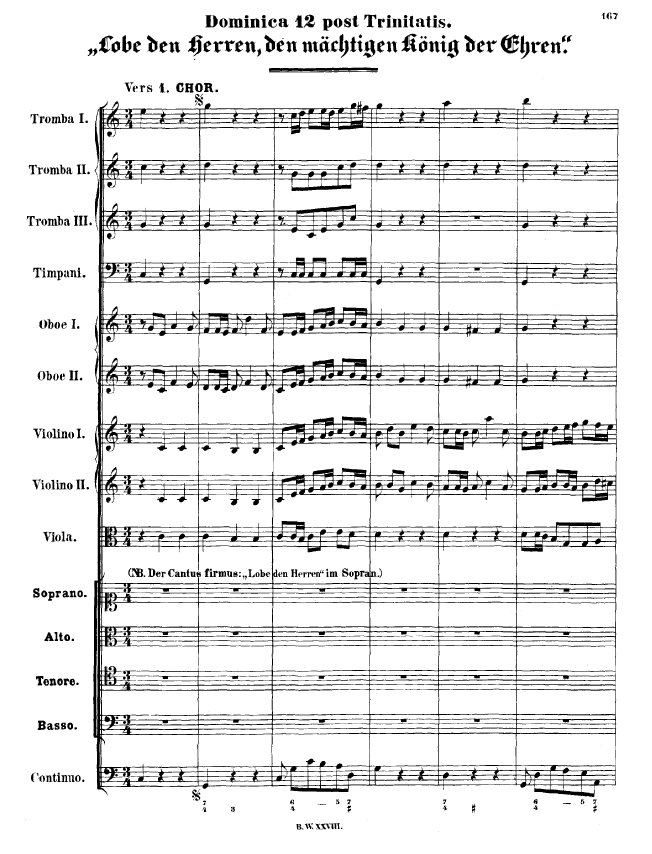 |
|
Aria for Alto Lobe den Herren, der Alles so herrlich regieret (Mvt. 2) from Cantata BWV 137 (verse 2) |
|
Form. Unison Choral for Alto. The cantus is treated freely (Violino Solo, Continuo). |
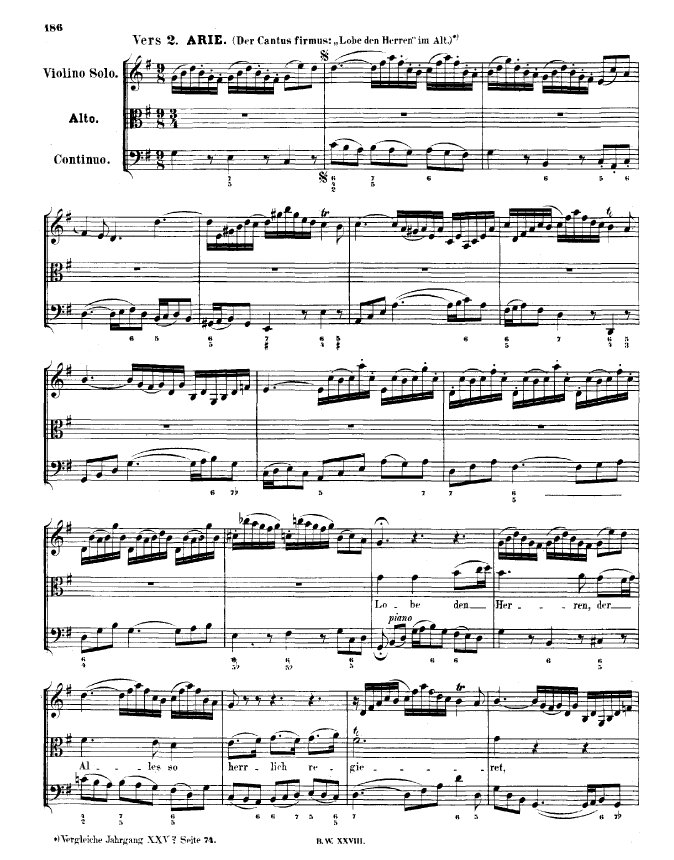 |
|
Aria for Soprano & Bass Lobe den Herren, der künstlich und fein dich bereitet (Mvt. 3) from Cantata BWV 137 (verse 3) |
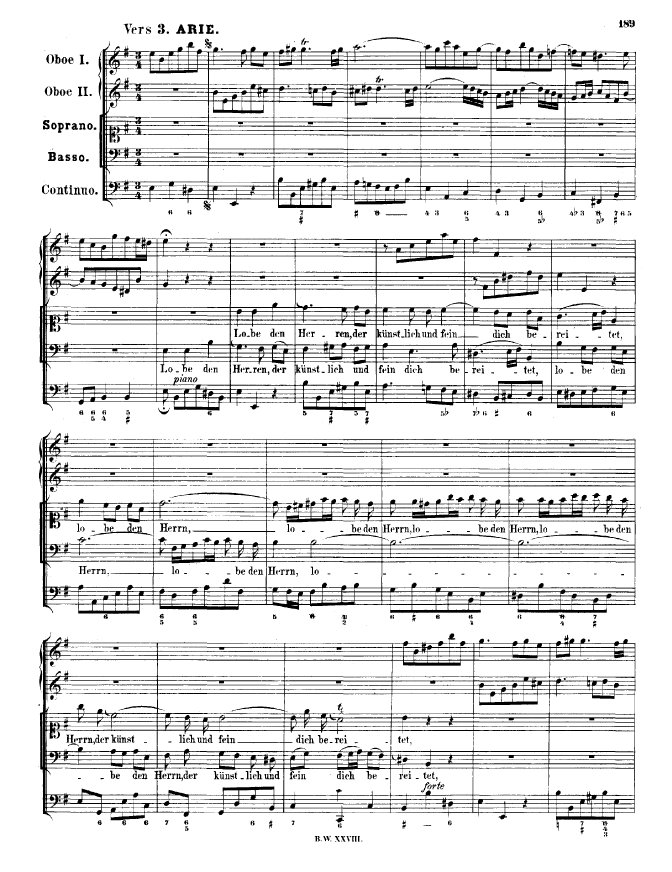 |
|
Aria for Tenor Lobe den Herren, der deinen Stand sichtbar gesegnet (Mvt. 4) from Cantata BWV 137 (verse 4) |
|
Form. Tenor Aria, the cantus being in the Tromba obbligato (Tromba, Continuo). |
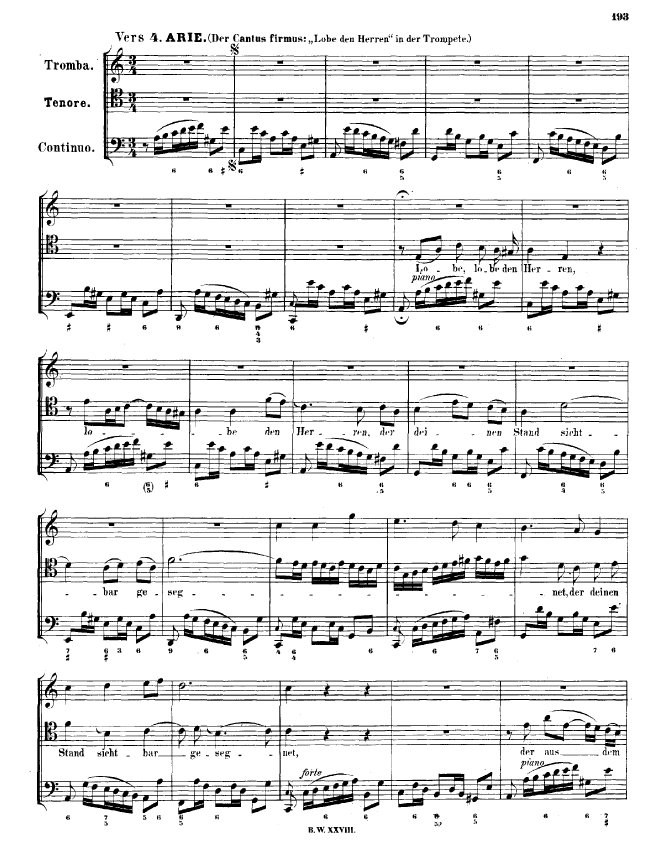 |
|
Aria for Tenor Lobe den Herren, was in mir ist, lobe den Namen (Mvt. 5) from Cantata BWV 137 (verse 5) |
|
Form. Embellished (3 Trombe, Timp., 2 Ob., Strings, Continuo). Choralgesange, No. 230. |
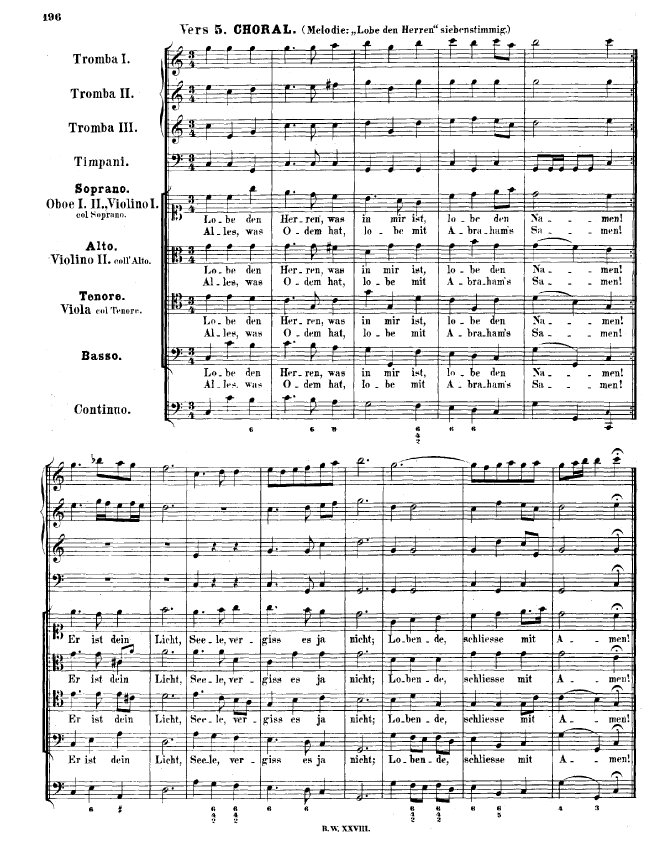 |
|
Untexted: |
|
Text 3: Kommst du nun, Jesu, vom Himmel herunter auf Erden? |
|
Chorale Prelude Kommst du nun, Jesu, vom Himmel herunter, BWV 650 |
|
The movement is No. 6 of the Schübler Chorals, and is an adaptation of the Alto Solo on the second stanza of Joachim Neander’s “Lobe den Herren, den mächtigen König der Ehren,” in Cantata BWV 137 (? 1732):
The accompaniment on the first Manual is a Violin Solo in the Cantata.
Thomas Braatz added (November 16-17, 2018):
Why did J.S. Bach specifically choose this text for BWV 650? I found an important connection related to J.S. Bach’s choice of a title for the Schübler organ prelude (BWV 650) “Kommst du nun, Jesu, vom Himmel herunter”: the entire CT is contained in an extensive set of CT's (without melody notations) in the ‘Wagner’ hymnal from 1697, which J.S. Bach had in his library, as documented in the listing of his estate in 1750. The CT that J.S. Bach referred to is listed as a Christmas and not Advent chorale as some sources have indicated and the CM recommended in the 1699 collection is not the one the J.S. Bach used for BWV 650! The mystery concerning this Schübler chorale continues…. |
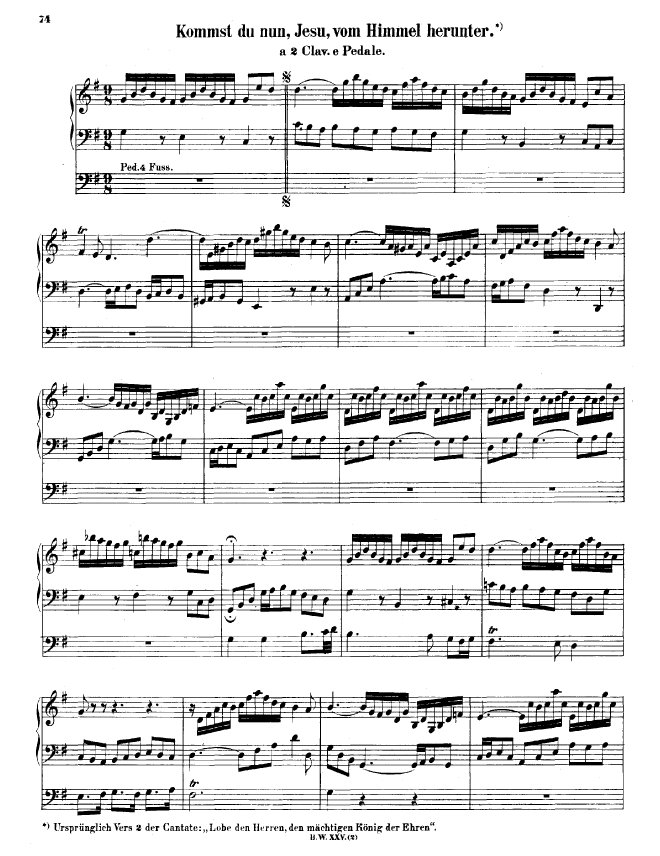 |
| |
| |
| |
|
Use of the Chorale Melody by other composers: |
| |
| |
| |
|
Sources: Bach Digital; BGA; Zahn; BCML discussions on BCW; Charles Sanford Terry's Bach Chorals books
Photos from Gottfried Vopelius: Neu Leipziger Gesangbuch (Vopelius 1682) & Christian Friedrich Witt: Psalmodia Sacra, Oder: Andächtige und schöne Gesänge… (Gotha Hymnal, 1715), were taken from digital copies of the books downloaded from Bayerische Staatsbibliothek München. These copies are Out of copyright - non commercial re-use (Europeana Rights).
Prepared by Aryeh Oron (October-November 2018) |